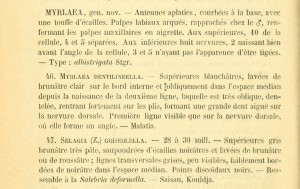

 +4Kontinente:EUAS
+4Kontinente:EUAS2. Diagnose
2.1. Erstbeschreibung
4. Weitere Informationen
4.1. Andere Kombinationen
- Selagia griseolella Ragonot, 1887 [Originalkombination]
4.2. Taxonomie
Anikin et al. (2017: 189) führen die Art noch in der Originalkombination Selagia griseolella Ragonot, 1887. Slamka (2019: 59-61) stellt für sie und eine weitere asiatische Art die neue Gattung Sareptania auf.
4.3. Faunistik
Locus typicus ist China: Yining, Saisan. Anikin et al. (2017: 189) führen die Art aus dem europäischen Teil von Russland für die Regionen Astrachan und Orenburg an. Slamka (2019: 60) schreibt: "Volgograd (Sarepta), Astrakhan, S-Ural (Orenburg), Turkmenistan (Kara-Kala), Uzbekistan (Bukhara, Samarkand), China (Yining, Saisan)." Er verweist darauf, dass das bei Leraut (2014: 389, fig. 165a) unter dem Namen "Pseudophycita deformella abgebildete Weibchen-Genital fehlbestimmt ist und in Wirklichkeit zu S. griseolella gehört, was wahrscheinlich auch für die Falter auf Pl. 36, figs. 14 u. 15 gilt.
4.4. Publikationsdatum der Erstbeschreibung
28. Dezember 1887 (Begründung siehe unter Acrobasis niveicinctella).
4.5. Literatur
- Anikin, V.V., Sachkov, S.A. & V.V. Zolotuhin (2017): "Fauna lepidopterologica Volgo-Uralensis": from P. Pallas to present days. — Proceedings of the Museum Witt Munich, Volume 7: 1-696; Munich and Vilnius.
- Leraut, P. (2014): Moths of Europe. Volume 4. Pyralids 2. - 441 S.; Verrières-le-Buisson (N.A.P Editions).
- Erstbeschreibung: Ragonot, E.-L. (1887): Diagnoses d'espèces nouvelles de Phycitidae d'Europe et des pays limitrophes. — Annales de la Société entomologique de France. 6e série 7 (3): 225-260. Paris.
- Slamka, F. (2019): Pyraloidea (Lepidoptera) of Europe. Volume 4. Phycitinae - Part 1. Identification - Distribution - Habitat - Biology. - 432 S., 175 Taf. mit Genitalabb., 31 Farbtaf. mit mehr als 900 Bildern zu 207 Arten; Bratislava (Eigenverlag František Slamka).







